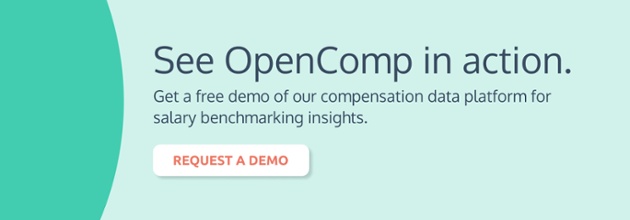Whether you have ten employees, 50, or more, it’s essential to ensure you have access to reliable compensation data that helps you attract and retain the best talent. However, given the complexity of pay data analysis, it can be difficult to tell if you’re getting your data from the best source and if the data is the right match for the roles in your organization.
Nowadays, many compensation surveys and websites claim to offer accurate and reliable compensation benchmarks, so it’s essential to know what to look for and the pitfalls to avoid. When you do, you can obtain best-fit compensation data that can help you make better employee pay decisions and keep your business moving forward.
The Importance of Great Employee Compensation Data
Successfully leading a high-growth business requires a team of high-performers who can help scale your business as it evolves. As a result, you might spend a great deal of time and effort deciding on pay packages for new and existing hires. To meet your business goals, you can’t afford to make these decisions based on inaccurate or unverified market data.
Furthermore, your business isn’t a decades-old public company, so you probably don’t want to pay like one. However, finding accurate comp data that is specific to the pre-IPO market can leave you comparing your job offers and employee pay packages to mismatched benchmarks, including large public companies and those with similarly titled but very different roles.
Conversely, when you have access to reliable and relevant pay data, you can build the best possible team. With this reliable data, you can make better decisions when presenting job offers and promoting top performers. More specifically, great compensation data will:
- Support more efficient use of your budget and reduce the incidence of unnecessary option pool dilution.
- Boost your understanding of market rates for key roles.
- Allow you to pay employees competitively and fairly.
- Help you identify trends in wages over time.
- Add more objectivity to compensation decisions, ultimately helping you build a better culture.
- Provide insights into how other organizations balance compensation components, such as cash compensation, equity, and perks.
Signs of Poor Salary Data
Although comp data can deliver a wealth of benefits to your organization, you miss out on those benefits when the data you use comes from unreliable sources or is incorrect. For example, making employee compensation decisions based on poor data can lead you to overspend or underspend your budget. It can also create or worsen pay inequities in your workforce.
Even if you’re not an HR or compensation expert, there are some tell-tale signs your organization may be relying on bad pay data:
- You get your compensation data from the internet, meaning it may come from non-credible and unverifiable sources.
- You don’t have access to industry comp data, and your data isn’t differentiated by funding size and other key characteristics.
- You don’t feel confident about your market compensation data because it’s based on information from large public companies.
- Your organization is losing employees, and they cite compensation as a key reason.
- You have seen great candidates decline job offers due to compensation.
Tips for Finding Great Comp Data
Although it’s not the only factor, compensation is a critical component in an employee’s decision to join or stay with a company. In a recent PwC survey, 65 percent of employees said they were looking for a new job, and the number one reason was compensation.
Employees who leave can impact your company’s ability to grow. They often leave gaps on teams, potentially resulting in initiatives and projects coming to a standstill. They can also be costly to replace, triggering unplanned recruitment and onboarding expenditures.
However, even when employees cite compensation as the reason for leaving, they may not be underpaid. Rather, they may leave because of perceptions about their pay, some of which may or may not be grounded in fact. For instance, some employees may not understand their pay, or they might suspect they are paid unfairly. Without accurate and reliable pay data, you will lack the information you need to make well-informed, data-driven compensation adjustments.
Thankfully, improving the quality and comprehensiveness of the data you use to retain great employees doesn’t require a team of compensation analysts or consultants. However, it does require taking action to ensure you have access to comp data that is complete, accurate, and appropriate for your organization. Take the following actions to get started:
Develop a Compensation Philosophy
Your compensation philosophy is a statement that guides your employee pay decisions. Without it, you can make the mistake of using salary data inconsistently or getting stuck when determining how you want to pay relative to the market.
With a well-thought-out compensation philosophy, you will have a clear roadmap for how to use comp data, including the decisions you make regarding:
- Your organization's mix of employee pay components (e.g., cash versus long-term incentives).
- Your organization’s target market position.
- Your pay strategy for different groups or geographic regions.
Utilize Reliable Compensation Software
With access to a compensation software solution designed specifically for high-growth organizations like yours, you don’t have to be limited to compensation survey benchmarks that lump together data from companies without regard to their size or location. Instead, you can make true apples-to-apples comparisons based on compensation inputs from similar organizations that match your funding stage, roles, and geographic locations. As a result, you can make pay decisions competitively and equitably across every part of your business.
With great software that delivers compensation intelligence to meet your needs, you can:
- Evaluate how your organization's pay data compares to other high-growth organizations.
- Access diversity, equity, and inclusion (DEI) evaluation tools to identify any pay equity gaps across your employee population.
- Model cash and equity burn scenarios based on future hiring plans.
- Map compensation based on geographic locations.
Monitor Employee Satisfaction and Retention
Losing even one great employee for compensation reasons can have a sizable impact on your organization. By monitoring the impact of your compensation decisions on employee satisfaction, retention, and other workforce trends, you will have the information you need to make adjustments that can help you keep your best people. For example, by tracking employee retention rate, time and cost to hire, and internal pay equity, you can better understand how compensation impacts the employee experience.
Improve Your Pay Practices with Reliable Salary Data
When you need to balance your goals for hiring and retaining employees with your need to manage cash and equity burn, your compensation practices naturally come front and center. To make compensation decisions that support your overall growth, you need pay data that will enhance the employee experience and help you find and keep the best talent.
When you go beyond traditional compensation surveys, you can unlock a wealth of compensation intelligence, including reliable salary data, benchmarks, and insights that put your compensation philosophy into action.
Whether your organization is in the seed stage or approaching IPO, OpenComp offers a dynamic solution to help you make the best compensation decisions for your business. With dashboards for market benchmarking, pay equity analysis, and long-range compensation planning, you can develop a clear roadmap for employee pay. To learn more, request a demo today or sign up for free.



